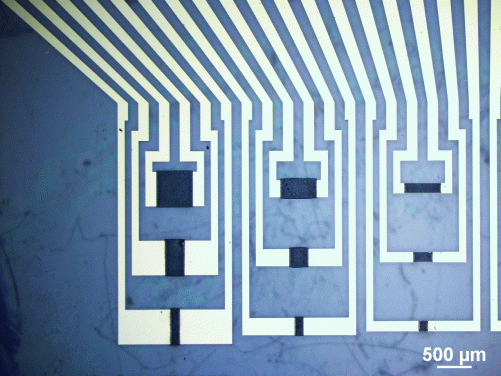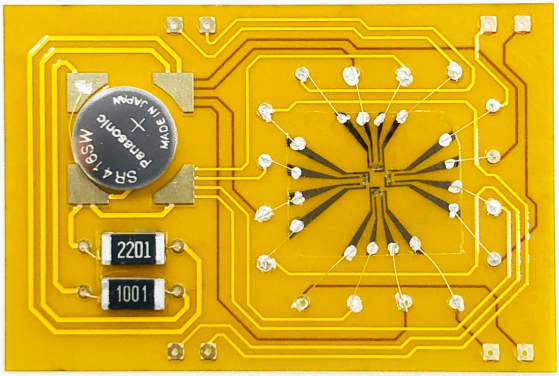Media
New wearable devices with huge medical value
HKU Mechanical Engineering team develops ECG sensor for detecting atrial fibrillation
14 Jul 2021
- 1 / 4
- 2 / 4
- 3 / 4
- 4 / 4
Advanced devices developed by a mechanical engineering team at the University of Hong Kong (HKU) has proven to be useful for detecting potential stroke patients and helping machines mimic human brain functions.
In a collaboration with Nanjing University, Dr Paddy K.L. Chan, Associate Professor at the Department of Mechanical Engineering, developed a novel wearable electrocardiogram (ECG) sensor by integrating flexible, ultra-thin organic semiconductors into a flexible polyimide substrate. Powered by button battery, the sensor has outstanding signal amplification properties with a gain larger than 10,000, which allows it to detect electrophysiological signal, or f-wave with a frequency of 357 beats per minute (BPM), which indicates atrial fibrillation.
Conventional portable ECG sensors cannot easily detect the f-wave due to its weak amplitude. Atrial fibrillation is the most common arrhythmia associated with the increased risk of stroke or heart failure. The high signal detection capability stems from the ultralow subthreshold swing (SS) in the organic field effect transistors (OFETs).
Dr Chan’s study showed the ECG sensor managed to pick up unusual signals from patients with atrial fibrillation, while conventional electrodes could not.
“People wearing the new sensors can also enjoy freedom of movement, run around or even take a shower if they want, not being attached to a machine. We have seen a breakthrough in application with the use of a new device structure,” he said. The finding has been published in Nature Communications, in the article entitled “Sub-thermionic, ultra-high-gain organic transistors and circuits.” (Note 1)
Dr Chan’s previous breakthrough in developing the staggered structure monolayer OFETs, the material used in the latest experiment, was published in Advanced Materials. A US patent was also filed for the innovation. In the latest work, his team has advanced the application of the monolayer OFETs to flexible substrate for wearable electronic applications.
“The subthreshold swing is an important parameter in transistor or inverter operation as it implies how much voltage change is needed to turn the device from “off” state to “on” state. Our devices provide a record low subthreshold swing device which ensures low operating power and high sensitivity,” Dr Chan said.
His team also succeeded in adding ‘memory’ or collected signal, information to an organic transistor, which paves the way for advanced machine learning to mimic human brain functions.
The work has been published in Nature Communications, in another article entitled “Mimicking associative learning using an ion-trapping non-volatile synaptic organic electrochemical transistor”. (Note 2)
“Our paper explains the physics behind how information can be stored in a device,” said Dr Chan. “It sets the stage for the next generation of computer learning through the enhancement of the ‘learning function’ of a device. For example, we can integrate the memory transistors with optical sensors for image processing and computation at the same time. The memory transistors are building blocks for the artificial neural network that can perform signal recognition or learn like a human brain.”
Dr Chan’s team successfully added the “ion retainer” polytetrahydrofuran (PTHF) into a conductive organic polymer PEDOT:TOS. The PTHF can significantly slow down the move in-and-out of the ions in the PEDOT:TOS channel layer and maintain them at the desired conductance state. Multi-conductance levels, which can be considered as “memory levels”, were achieved. The experiment was held jointly with Northwestern University.
There is vast room for research in this area of human-machine interface, with unthinkable benefits for mankind. “There are unlimited possibilities when it comes to the applications of such interface,” added Dr Chan. In the meantime, however, he said that his focus would be on developing sophisticated circuit using advanced materials.
About HKU Faculty of Engineering
The Faculty of Engineering is one of the founding Faculties of The University of Hong Kong established in 1912. Since its foundation, the Faculty has kept pace with developments in the engineering world and is always at the forefront of engineering research, evolving into one of the largest Faculties at the University with five departments providing undergraduate, postgraduate and research degrees in a wide range of important fields of modern engineering, technology and computer science. The Faculty aims at providing an all-round education for students, equipping graduates not only with knowledge of cutting-edge technology, but also excellent communication and social skills, an innovation mindset, a lifelong learning attitude, professional integrity and international exposure. For more information, visit https://engg.hku.hk.
Media enquiries:
Ms Celia Lee, Faculty of Engineering, HKU (Tel: 3917 8519; Email: leecelia@hku.hk) or
Mr Heng Cheng, Faculty of Engineering, HKU (Tel: 3917 1924; Email: hengc@hku.hk)
Note:
1. Nature Communications volume 12, Article number: 1928 (2021)
https://www.nature.com/articles/s41467-021-22192-2
2. Nature Communications volume 12, Article number: 2480 (2021)
https://www.nature.com/articles/s41467-021-22680-5


